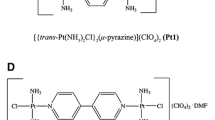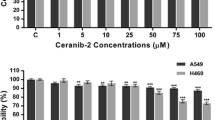Abstract
Introduction
Chemotherapy for advanced well-differentiated carcinoids is characterised by low response rates and short duration of responses. The present study aimed to assess the in vitro activity of novel platinum-based chemotherapeutic drugs in combination with dichloroacetate (DCA), a sensitiser to apoptosis, against lung carcinoid cell lines.
Methods
Three permanent cell lines (UMC-11, H727 and H835) were exposed to 14 different established cytotoxic drugs and the novel platinum-based compounds as satraplatin, JM118 and picoplatin in combination with DCA, and viability of the cells was measured using a tetrazoliumbased dye assay.
Results
With exception of the highly chemoresistant UMC-11 line, the carcinoid cell lines (H727, H835) were sensitive to the majority of chemotherapeutics in vitro. Among the platinum-based drugs, carboplatin and oxaliplatin showed highest efficacy. H835 cells growing as multicellular spheroids were 2.7–8.7-fold more resistant to picoplatin, satraplatin and its metabolite compared to single cell suspensions. DCA (10 mM) inhibited the growth of UMC-11 cells by 22% and sensitised these highly resistant cells to carboplatin, satraplatin and JM118 1.4–2.4-fold.
Conclusion
The highly resistant UMC-11 lung carcinoid cells are sensitive to carboplatin, oxaliplatin and the satraplatin metabolite JM118, but multicellular spheroidal growth, as observed in the H835 cell line and pulmonary tumourlets, seems to increase chemoresistance markedly. The activity of carboplatin and JM118 is significantly and specifically increased in combination with the apoptosis sensitiser DCA that promotes mitochondrial respiration over aerobic glycolysis. In summary, among the novel platinum drugs satraplatin has the potential for treatment of lung carcinoids and DCA potentiates the cytotoxicity of selected platinum drugs.
Similar content being viewed by others
References
Öberg K (2003) Diagnosis and treatment of carcinoid tumors. Expert Rev Anticancer Ther 3:863–877
Modlin IM, Kidd M, Latich I et al (2005) Current status of gastrointestinal carcinoids. Gastroenterology 128:1717–1751
Pinchot SN, Holen K, Sippel RS, Chen H (2008) Carcinoid tumors. Oncologist 13:1255–1269
Zuetenhorst JM, Taal BG (2005) Metastatic carcinoid tumors: a clinical review. Oncologist 10:123–131
Granberg D, Oberg K (2005) Neuroendocrine tumours. Cancer Chemother Biol Response Modif 22:471–483
Capella C, Heitz PU, Hofler H et al (1995) Revised classification of neuroendocrine tumors of the lung, pancreas and gut. Virchows Arch 425:547–560
Warren WH, Gould VE, Faber LP et al (1985) Neuroendocrine neoplasms of the bronchopulmonary tract: a classification of the spectrum of carcinoid to small cell carcinoma and intervening variants. J Thorac Cardiovasc Surg 89:819–825
Plockinger U, Rindi G, Arnold R et al (2004) European Neuroendocrine Tumour Society: guidelines for the diagnosis and treatment of neuroendocrine gastrointestinal tumours. A consensus statement on behalf of the European Neuroendocrine Tumour Society (ENETS). Neuroendocrinology 80:394–424
Öberg K, Eriksson B (2005) Nuclear medicine in the detection, staging and treatment of gastrointestinal carcinoid tumours. Best Pract Res Clin Endocrinol Metab 19:265–276
Dousset B, Saint-Marc O, Pitre J et al (1996) Metastatic endocrine tumors: medical treatment, surgical resection and liver transplantation. World J Surg 20:908–915
Raderer M, Kurtaran A, Leimer M et al (2000) Value of peptide receptor scintigraphy using (123) I-vasoactive intestinal peptide and (111)In-DTPAD-Phe1-octreotide in 194 carcinoid patients: Vienna University Experience, 1993 to 1998. J Clin Oncol 18:1331–1336
Smolle-Juttner FM, Popper H, Klemen H et al (1993) Clinical features and therapy of “typical” and “atypical” bronchial carcinoid tumors (grade 1 and grade 2 neuroendocrine carcinoma). Eur J Cardiothorac Surg 7:121–125
Marty-Ane CH, Costes V, Pujol JL et al (1995) Carcinoid tumors of the lung: do atypical features require aggressive management? Ann Thorac Surg 59:78–83
Moertel CG, Sauer WG, Dockerty MB, Baggenstoss AH (1961) Life history of the carcinoid tumor of the small intestine. Cancer 14:901–912
Goodwin JD (1975) Carcinoid tumors: an analysis of 2837 cases. Cancer 36:560–569
Bertino EM, Confer PD, Colonna JE et al (2009) Pulmonary neuroendocrine/carcinoid tumors: a review article. Cancer 115:4434–4441
Moertel CG (1983) Treatment of the carcinoid tumor and the malignant carcinoid syndrome. J Clin Oncol 1:727–740
Sun W, Lipsitz S, Catalano P et al (2005) Phase II/III Study of doxorubicin with fluorouracil compared with streptozocin with fluorouracil or dacarbazine in the treatment of advanced carcinoid tumors: Eastern Cooperative Oncology Group Study E1281. J Clin Oncol 23:4897–4904
Dowell JE (2010) Small cell lung cancer: are we making progress? Am J Med Sci 339:68–76
Shah N, Dizon DS (2009) New-generation platinum agents for solid tumors. Future Oncol 5:33–42
Dhar S, Lippard SJ (2009) Mitaplatin, a potent fusion of cisplatin and the orphan drug dichloroacetate. Proc Natl Acad Sci U S A 106:22199–22204
Chong CD, Logothetis CJ, Savaraj N et al (1988) The correlation of vinblastine pharmacokinetics to toxicity in testicular cancer patients. J Clin Pharmacol 28:714–718
Rowinsky EK, Burke PJ, Karp JE et al (1989) Phase I and pharmacodynamic study of taxol in refractory acute leukemias. Cancer Res 49:4640–4647
Dennis MJ, Beijnen JH, Grochow LB, van Warderdam LJC (1997) An overview of the clinical pharmacology of topotecan. Semin Oncol 24:12–18S
Ho DH, Pazdur R, Covington W et al (1998) Comparison of 5-fluorouracil pharmacokinetics in patients receiving continuous 5-fluorouracil infusion and oral uracil plus N1-(2′-tetrahydrofuryl)-5-fluorouracil. Clin Cancer Res 4:2085–2088
Wihlm J, Limacher JM, Leveque D et al (1997) Pharmacokinetic profile of high-dose doxorubicin administered during a 6 h intravenous infusion in breast cancer patients. Bull Cancer 84:603–608
Touroutoglou N, Gravel D, Raber MN et al (1998) Clinical results of a pharmacodynamically-based strategy for higher dosing of gemcitabine in patients with solid tumors. Ann Oncol 9:1003–1008
Kivisto KT, Villikka K, Nyman L et al (1998) Tamoxifen and toremifene concentrations in plasma are greatly decreased by rifampicin. Clin Pharmacol Ther 64:648–654
Bonetti A, Franceschi T, Apostoli P et al (1995) Cisplatin pharmacokinetics using a five-day schedule during repeated courses of chemotherapy in germ cell tumors. Ther Drug Monit 17:25–32
Graham MA, Lockwood GF, Greenslade D et al (2000) Clinical pharmacokinetics of oxaliplatin: a critical review. Clin Cancer Res 6:1205–1218
Oguri S, Sakakibara T, Mase H et al (1988) Clinical pharmacokinetics of carboplatin. J Clin Pharmacol 28:208–215
Schilcher RB, Young JD, Ratanatharathorn V et al (1984) Clinical pharmacokinetics of highdose mitomycin C. Cancer Chemother Pharmacol 13:186–190
Adolphe AB, Glasofer ED, Troetel WM et al (1975) Fate of streptozotocin (NSC-85998) in patients with advanced cancer. Cancer Chemother Rep 9:547–556
Hande K, Messenger M, Wagner J et al (1999) Inter- and intrapatient variability in etoposide kinetics with oral and intravenous drug application. Clin Cancer Res 5:2742–2747
Chabot GG, Flaherty LE, Valdivieso M, Baker LH (1990) Alteration of DTIC pharmacokinetics after interleukin-2 administration in melanoma patients. Cancer Chemother Pharmacol 27:157–160
Kvols LK, Moertel CG, O’Connell MJ et al (1986) Treatment of the malignant carcinoid evaluation of a long-acting somatostatin analog. N Engl J Med 315:663–666
Engstrom PF, Lavin PT, Moertel CG et al (1984) Streptozotocin plus fluorouracil versus doxorubicin therapy for metastatic carcinoid tumor. J Clin Oncol 8:865–890
Vilar E, Salazar R, Pérez-García J et al (2007) Chemotherapy and role of the proliferation marker Ki-67 in digestive neuroendocrine tumors. Endocr Relat Cancer 14:221–23
García-Yuste M, Matilla JM, Cueto A et al (2007) Typical and atypical carcinoid tumours: analysis of the experience of the Spanish Multi-centric Study of Neuroendocrine Tumours of the Lung. Eur J Cardiothorac Surg 31:192–197
Giaccone G, Battey J, Gazdar AF et al (1992) Neuromedin B is present in lung cancer cell lines. Cancer Res 52:2732s–2736s
Saltz L, Lauwers G, Wiseberg J, Kelsen D (1993) A phase II trial of carboplatin in patients with advanced APUD tumors. Cancer 72:619–622
Skov BG, Holm B, Erreboe A et al (2010) ERCC1 and Ki67 in small cell lung carcinoma and other neuroendocrine tumors of the lung: distribution and impact on survival. J Thorac Oncol 5:453–459
Kelly K (2000) New chemotherapy agents for small cell lung cancer. Chest 117:156–162S
Teicher BA (2008) Newer cytotoxic agents: attacking cancer broadly. Clin Cancer Res 14:1610–1617
Ansell SM, Pitot HC, Burch PA et al (2001) A phase II study of high-dose paclitaxel in patients with advanced neuroendocrine tumors. Cancer 91:1543–1548
Iyer L, Ratain MJ (1998) Clinical pharmacology of camptothecins. Cancer Chemother Pharmacol 42:S31–S43
Catimel G, Chabot GG, Guastalla JP et al (1995) Phase I and pharmacokinetic study of irinotecan (CPT-11) administered daily for three consecutive days every three weeks in patients with advanced solid tumors. Ann Oncol 6:133–140
Lyons JM 3rd, Abergel J, Thomson JL et al (2009) In vitro chemoresistance testing in well-differentiated carcinoid tumors. Ann Surg Oncol 16:649–655
Porter AT, Ostrowski MJ (1988) Successful treatment of malignant carcinoid tumour with intravenous cisplatinum. Eur J Surg Oncol 14:703–704
Olszewski U, Hamilton G (2010) A better platinum-based anticancer drug yet to come? Anticancer Agents Med Chem 10:293–301
Wasilewski M, Scorrano L (2009) The changing shape of mitochondrial apoptosis. Trends Endocrinol Metab 20:287–294
Michelakis ED, Webster L, Mackey JR (2008) Dichloroacetate (DCA) as a potential metabolictargeting therapy for cancer. Br J Cancer 99:989–994
Sun RC, Fadia M, Dahlstrom JE et al (2010) Reversal of the glycolytic phenotype by dichloroacetate inhibits metastatic breast cancer cell growth in vitro and in vivo. Breast Cancer Res Treat 120:253–260
Otterson GA, Wang L, Wu X et al (2008) Effect of dichloroacetate in combination with chemotherapy on human lung cancer cells. J Clin Oncol 26S:14637
Dhar S, Lippard SJ (2009) Mitaplatin, a potent fusion of cisplatin and the orphan drug dichloroacetate. Proc Natl Acad Sci U S A 106:22199–22204
Li T, Schultz I, Keys DA et al (2008) Quantitative evaluation of dichloroacetic acid kinetics in human: a physiologically based pharmacokinetic modeling investigation. Toxicology 245: 35–48
Author information
Authors and Affiliations
Corresponding author
Rights and permissions
About this article
Cite this article
Fiebiger, W., Olszewski, U., Ulsperger, E. et al. In vitro cytotoxicity of novel platinum-based drugs and dichloroacetate against lung carcinoid cell lines. Clin Transl Oncol 13, 43–49 (2011). https://doi.org/10.1007/s12094-011-0615-z
Received:
Accepted:
Published:
Issue Date:
DOI: https://doi.org/10.1007/s12094-011-0615-z




